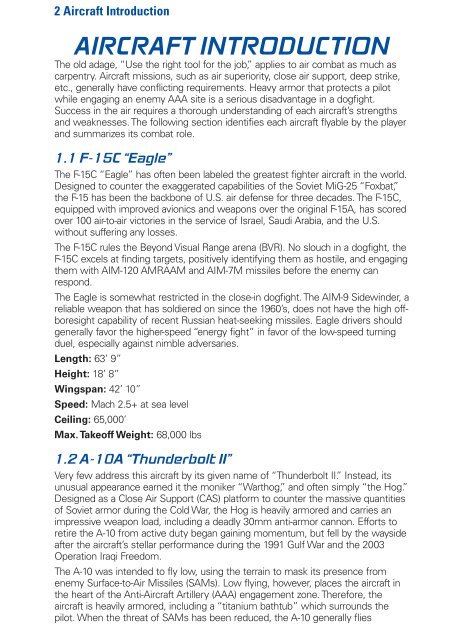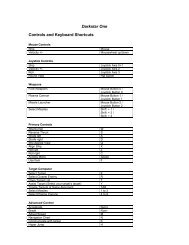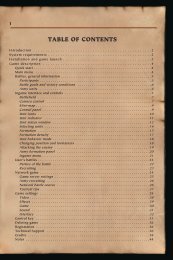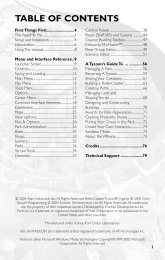Heads-Up Display Modes 35 - Metaboli
Heads-Up Display Modes 35 - Metaboli
Heads-Up Display Modes 35 - Metaboli
You also want an ePaper? Increase the reach of your titles
YUMPU automatically turns print PDFs into web optimized ePapers that Google loves.
2 Aircraft Introduction<br />
AIRCRAFT INTRODUCTION<br />
The old adage, “Use the right tool for the job,” applies to air combat as much as<br />
carpentry. Aircraft missions, such as air superiority, close air support, deep strike,<br />
etc., generally have conflicting requirements. Heavy armor that protects a pilot<br />
while engaging an enemy AAA site is a serious disadvantage in a dogfight.<br />
Success in the air requires a thorough understanding of each aircraft’s strengths<br />
and weaknesses. The following section identifies each aircraft flyable by the player<br />
and summarizes its combat role.<br />
1.1 F-15C “Eagle”<br />
The F-15C “Eagle” has often been labeled the greatest fighter aircraft in the world.<br />
Designed to counter the exaggerated capabilities of the Soviet MiG-25 “Foxbat,”<br />
the F-15 has been the backbone of U.S. air defense for three decades. The F-15C,<br />
equipped with improved avionics and weapons over the original F-15A, has scored<br />
over 100 air-to-air victories in the service of Israel, Saudi Arabia, and the U.S.<br />
without suffering any losses.<br />
The F-15C rules the Beyond Visual Range arena (BVR). No slouch in a dogfight, the<br />
F-15C excels at finding targets, positively identifying them as hostile, and engaging<br />
them with AIM-120 AMRAAM and AIM-7M missiles before the enemy can<br />
respond.<br />
The Eagle is somewhat restricted in the close-in dogfight. The AIM-9 Sidewinder, a<br />
reliable weapon that has soldiered on since the 1960’s, does not have the high offboresight<br />
capability of recent Russian heat-seeking missiles. Eagle drivers should<br />
generally favor the higher-speed “energy fight” in favor of the low-speed turning<br />
duel, especially against nimble adversaries.<br />
Length: 63’ 9”<br />
Height: 18’ 8”<br />
Wingspan: 42’ 10”<br />
Speed: Mach 2.5+ at sea level<br />
Ceiling: 65,000’<br />
Max. Takeoff Weight: 68,000 lbs<br />
1.2 A-10A “Thunderbolt II”<br />
Very few address this aircraft by its given name of “Thunderbolt II.” Instead, its<br />
unusual appearance earned it the moniker “Warthog,” and often simply “the Hog.”<br />
Designed as a Close Air Support (CAS) platform to counter the massive quantities<br />
of Soviet armor during the Cold War, the Hog is heavily armored and carries an<br />
impressive weapon load, including a deadly 30mm anti-armor cannon. Efforts to<br />
retire the A-10 from active duty began gaining momentum, but fell by the wayside<br />
after the aircraft’s stellar performance during the 1991 Gulf War and the 2003<br />
Operation Iraqi Freedom.<br />
The A-10 was intended to fly low, using the terrain to mask its presence from<br />
enemy Surface-to-Air Missiles (SAMs). Low flying, however, places the aircraft in<br />
the heart of the Anti-Aircraft Artillery (AAA) engagement zone. Therefore, the<br />
aircraft is heavily armored, including a “titanium bathtub” which surrounds the<br />
pilot. When the threat of SAMs has been reduced, the A-10 generally flies















